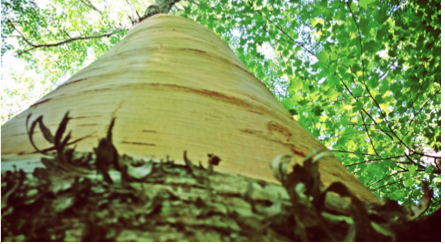 |
Wiigwaasi-jiimaan
Birchbark canoe project
2013
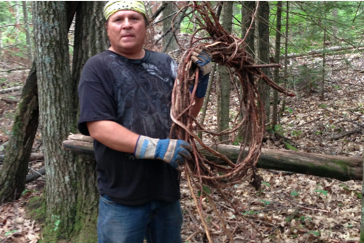
Wayne Valliere, (Mino-Giizhig) (TF)
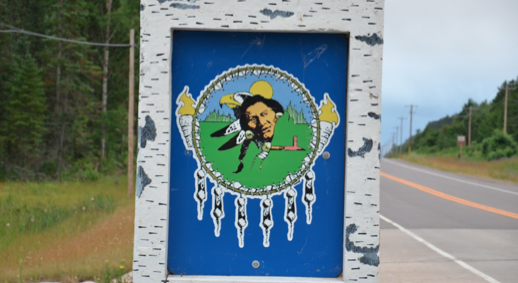
The Lac du Flambeau shield on bridge entering reservation (TD)
Boozhoo!
The Windgate Charitable Foundation, the University of Wisconsin-Madison School of Art, the UW Department of Comparative Literature and Folklore Studies, the UW Collaborative Center for Health Equity, The Center for the Study of Upper Midwestern Cultures, the UW-M Office of the Vice Provost and Chief Diversity Officer, the Wisconsin Humanities Council, the Brittingham Foundation, the Goodman Community Center and the Lac du Flambeau ENVISION program are thrilled to welcome contemporary Ojibwe artist and cultural educator Wayne Valliere (Mino-Giizhig) of the Lac du Flambeau Band of Lake Superior Chippewa Indians to campus to build a traditional Ojibwe birchbark canoe (wiigwaasi-jiimaan) during the fall semester of 2013. Mr. Valliere will share details of the elaborate and careful work that goes into the making of a traditional canoe with students, staff, and community members. All who are interested can follow the process of the canoe's construction, from the harvesting of materials (cedar, birch bark, spruce roots, and pine pitch) through construction of the canoe, to its finishing work and maiden voyage. If you are not able to visit the UW campus in person to meet Wayne and talk with him about his art the significance of the wiigwaasi-jiimaan to contemporary Ojibwe life, you can follow the process of the canoe's construction on this site. We are glad that you have come to visit--in person or online--and we hope you will stop by often to watch the progress of this exciting project.
What's Been Done So Far...
Harvesting:
(back to top)
Wiigwaas: birch bark
Wayne and his crew of helpers harvested birchbark for the canoe in late June and early July, when the bark "pops" from the birch trees. During this season, the birchbark is at its strongest, and birch trees can most easily heal after bark has been harvested. Birchbark is also harvested at other times of the year, but for different purposes. In Ojibwe culture, wiigwaas is regarded as an essential material for life. Anishinaabe people used the material for constructing watertight implements like canoes and boiling baskets, for storage of foodstuffs, for constructing lightweight and useful baskets and containers, and even as a cooking utensil. If one harvests birchbark in the proper way, it can be harvested without doing permanent damage to the tree. Larger pieces necessary for the hull of a 14-foot canoe will often end up leading to the tree's death. Such large pieces, however, are harvested from only very large, mature trees that are near the end of their lives. By harvesting these large trees, space is opened up for younger trees to fill in. Young trees also sprout from the roots of the trunk, regenerating the tree's life. And the wood lies in the forest and is frequently returned to after the wood has cured. The wood of a felled tree is often used for canoe thwarts, paddles, and other handcrafts. Any remaining materials from the tree becomes a source of life for various insects, birds and animals that move in, or shelter within its branches.
Video of Wayne harvesting birchbark (TD)
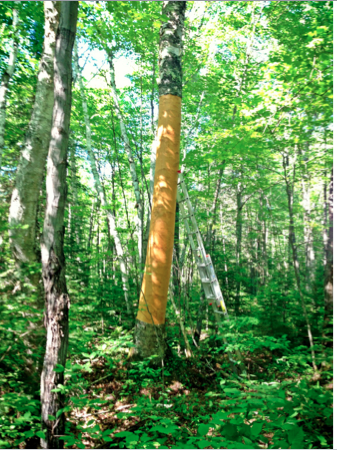
Birch tree with large section of bark removed for the hull of the canoe (TF)
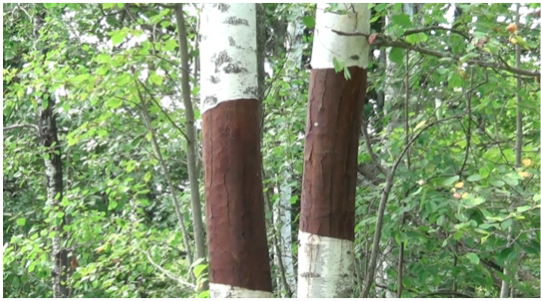
Living birch trees from which smaller pieces of bark have been harvested in previous years (TD)
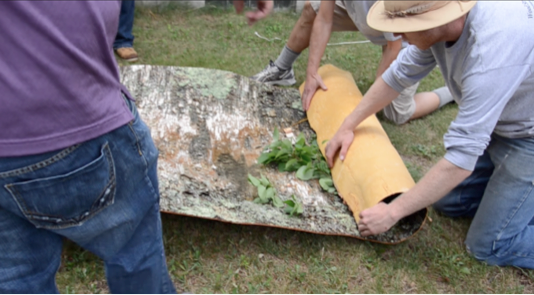
Harvested birchbark is rolled into bundles to be stored in a cool, dark, moist place (TD)
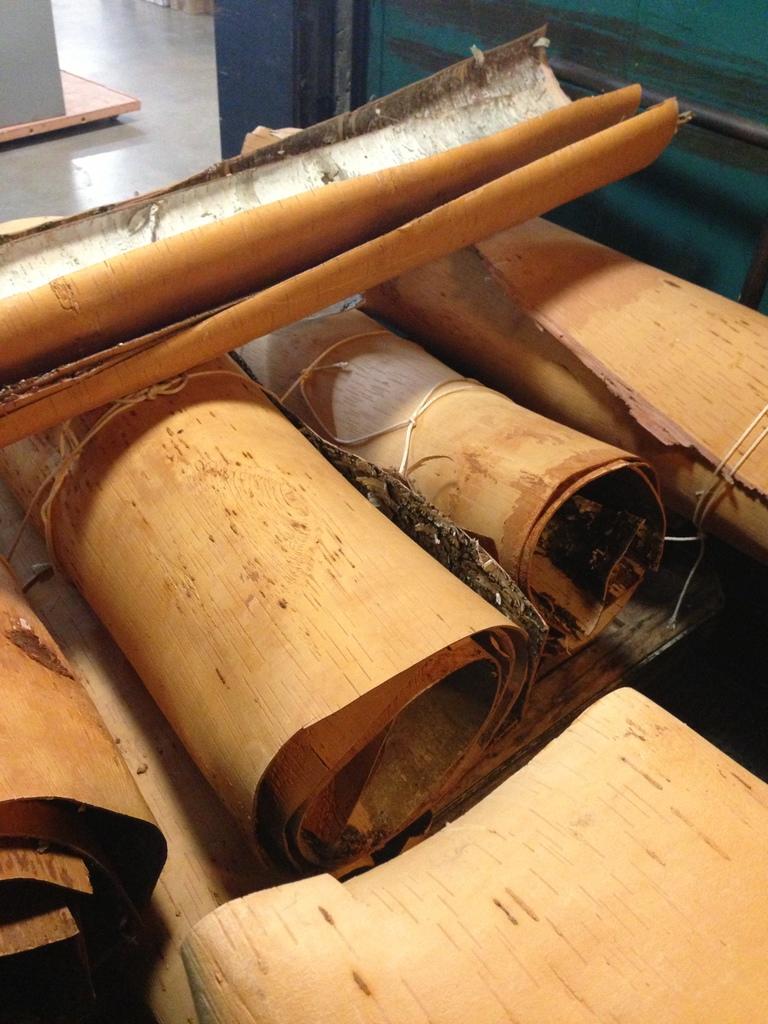
Bundles of birchbark stored in Wayne's basement (MC) Though bark is most pliable when it is fresh, bark can be dried and rehydrated after many years of proper storage
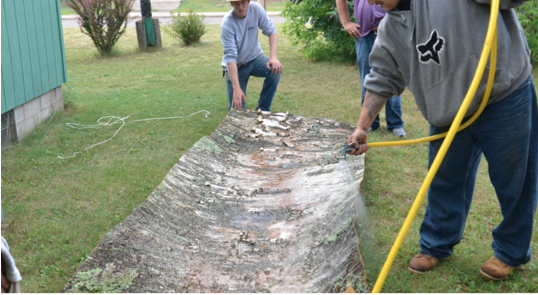
Rolls of birchbark must be periodically unrolled and rehydrated (TD)
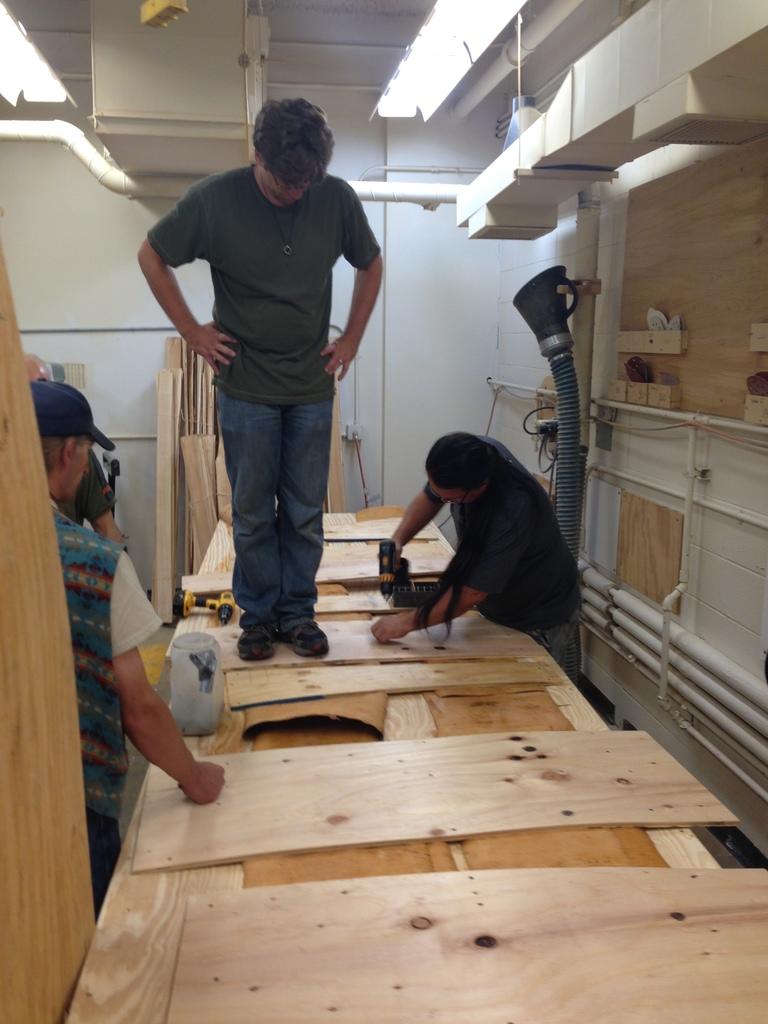
Wayne and crew flattening pieces of side-panel birchbark at the wood shop, University of Wisconsin. (MC)
(back to top)
Giizhig: white cedar
Northern white cedar is used for many parts of the canoe, most importantly the bimikwaanaatigoon (gunwales), the waaginaag (ribs), the inini-bagoog (manboards), and the waaganaawinzh (stempieces). Cedar is also used for making the sheathing that prevents passengers from placing their feet directly onto the birchbark skin of the boat. Cedar is naturally resistant to rot, and straight grained cedar can be bent exceptionally well after soaking and steaming.
Wayne looks for mature trees that have grown straight (i.e., not twisted) and that do not have side branches (which cause knots) for at least a length of five feet. When a suitable tree is felled, a workable length of trunk is taken and split repeatedly to produce a series of thick rough-cut boards. By splitting the trunk pieces with a hatchet or by hand, Wayne ensures that the grain runs continuously from one end of the board to the other. This continuity of grain will prevent the boards from cracking during the bending process, and over time as they age. Although the boards are initially split by hand, Wayne then uses an electric planer to reduce the width of each board to a workable thickness. Lower quality cedar stock is planed down even thinner to form the sheathing. Traditionally, this process was done using the waagikomaan (crooked knife), which is still an essential tool during many parts of the canoe-building process.
As with the birch, the parts of the cedar that are not used in the boat are left to dry out in the forest. As Wayne says, "The forest is my lumber yard; I can go back to that tree later and harvest the things I need from it at that point, like wood to make my ricing sticks."
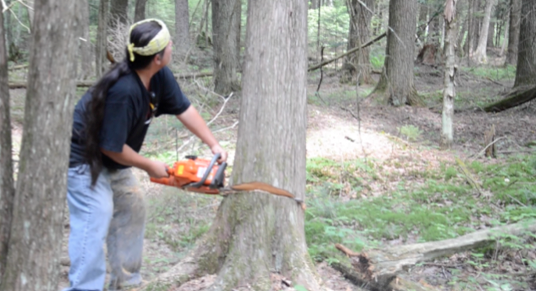
Wayne using a chainsaw to cut down a mature cedar of requisite size and shape (TD)
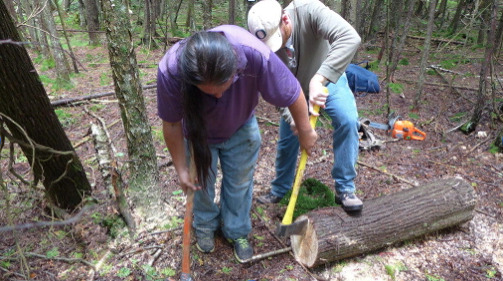
Wayne using an ax and sledge hammer to score a straight vertical line across the end of a cedar log cut to the length needed for the canoe's ribs and sheathing. Driving the axe head into the wood along this line will begin to split the log into two halves (CC)
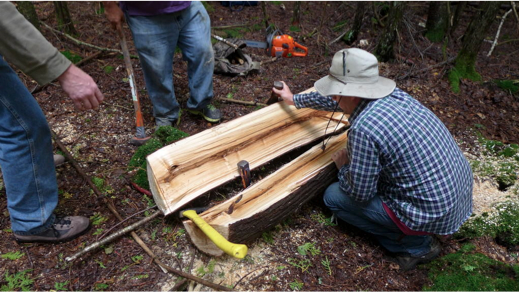
The work of further splitting the log can be completed using a wedge and sledge hammer. Wedges are placed inside the split that develops along the log's length and is then hammered into the log, causing the crack to widen until finally the log splits in two (CC)
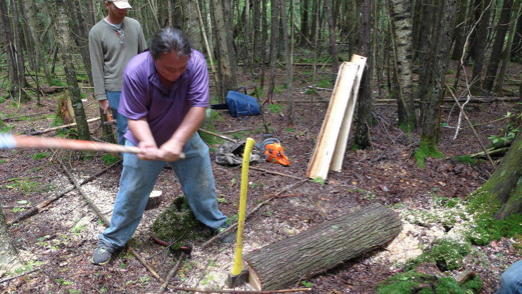
The same process of scoring, hammering from the edge, and wedging from the side is used to further split the log into quarters. Note finished rough cut planks behind. By doing the work in the forest, the crew reduces the amount and weight of the wood that must be hauled back to the road and placed in Wayne's truck. Unwanted pieces, stripped bark, and wood splinters are left to return to the soil. Larger pieces can be returned to for other projects requiring cedar. (CC)
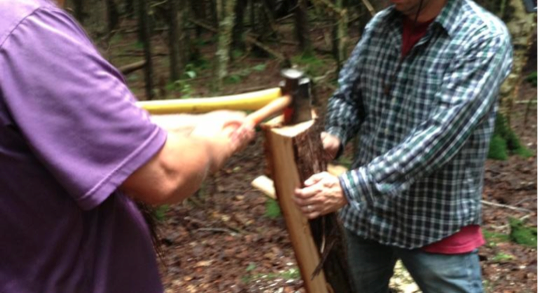
Once the log has been cut into quarters and is lighter to handle, the work of further splitting continues by holding the log vertically. A single log quarter can be split into only one or at most a few planks suitable for the canoe's ribs or sheathing (TD)
Watch Wayne Valliere and Tim Frandy split a log into a plank (TD)
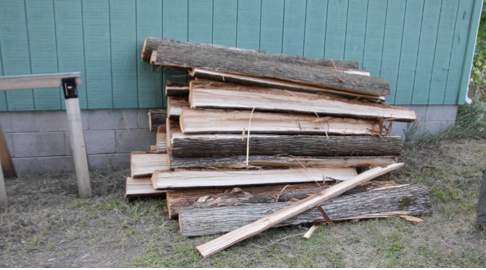
The finer work of splitting log sections into rough planks can be done in the forest or at home. Here Wayne and his crew have hauled quartered logs home to be processed into planks behind Wayne's garage/studio (TD)
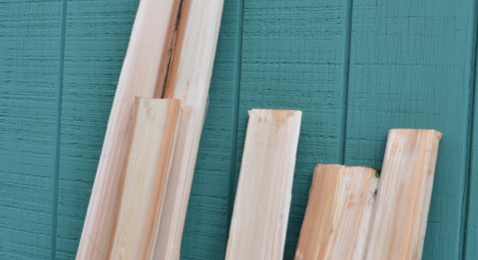
Rough cut cedar planks drying behind Wayne's garage. The planks will eventually be planed down to a width thin enough to allow bending when soaked or steamed (TD)
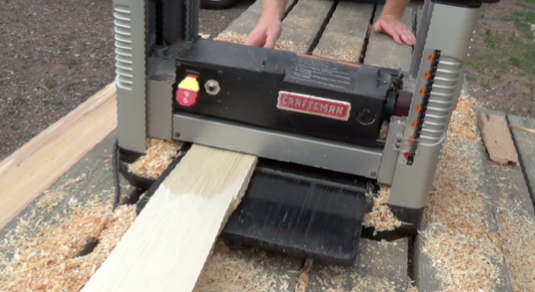
The thick planks are planed down to the right thickness using an electric planer. Wayne and his crew completed some of this work outside on the Lac du Flambeau reservation, but the rest of the process is being done at the wood studio at the University of Wisconsin-Madison's Art Department (TD)
The inini-bagoog (manboards), also of white cedar, are essential structural features of the canoe that also provide a place for expressive statements. They hold the canoe’s gunwales in place and anchor the stempiece of the canoe. Wayne uses the manboards as a place to display his clan identity and to celebrate some of the rich mythic symbolism that pervades traditional Anishinaabe life. In the bow he burns a bear (his own clan, inherited from his father), and in the stern he burns a turtle (the clan of his mother).
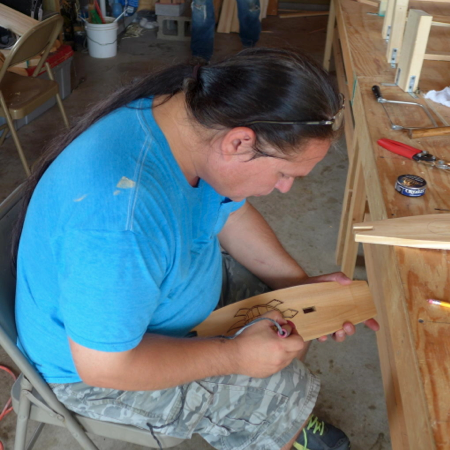
Wayne decorating one of the canoe's two inini-bagoog with a turtle symbol (CC)
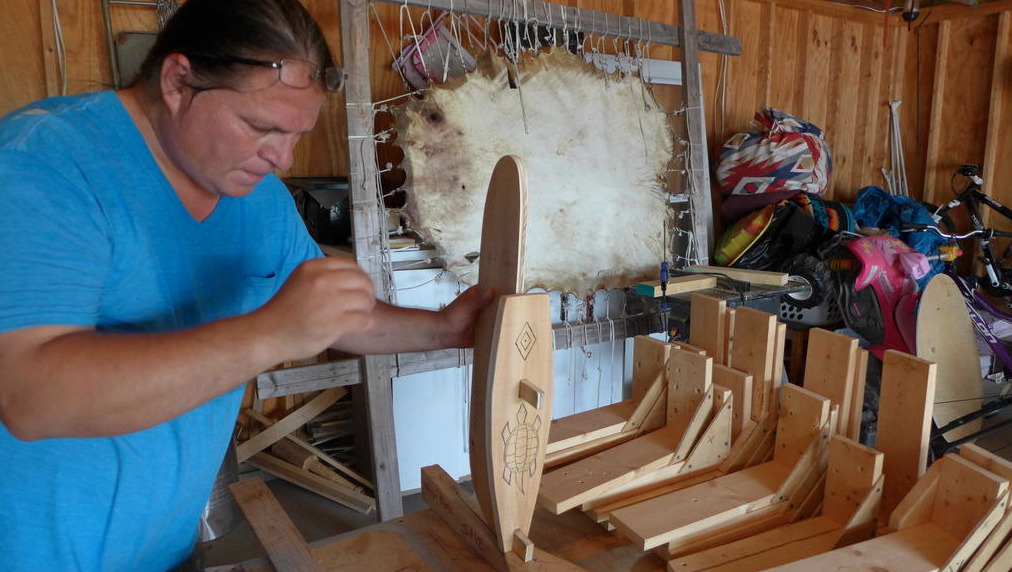
Checking the fit and size of the turtle manboard before mounting to the stempiece (CC)
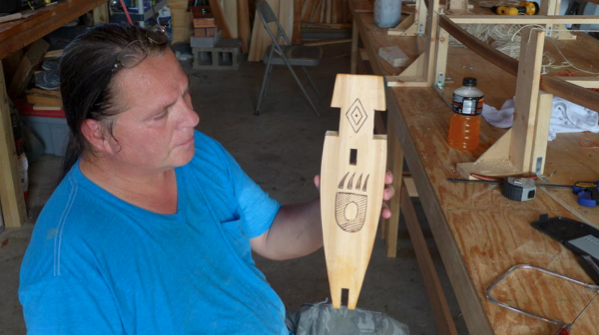
Wayne showing one of the canoe's two inini-bagoog, decorated with a bear paw symbol. The shape of the finished piece explains the name "manboard" (CC)
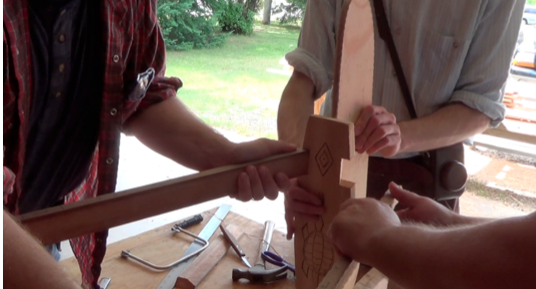
Fitting the soaked and bendable inwale pieces to the manboard. The pieces were tied and stabilized so that the inwale pieces would dry in exactly the right shape (TD)
Waatabiig: spruce roots
Knotless spruce roots, split into long (c. 5-16 foot) lengths, and smoothed into flat, even form, are used to sew the various parts of the canoe together. Wayne looks for trees that are growing a little apart from other trees, in good workable soil. By working the soil near the base of the trunk, he locates the start of roots of sufficient width (about an inch wide). Using a digging tool like a pick axe, he carefully unearths the root as it runs through the soil away from the tree. Ideally, the root will run in a straight line, but it may also fork or dive downward or veer to avoid stones, etc. The work of pullling up a root must be done with patience and care, otherwise it will break and the resulting piece may be too short to be of any use. Naturally, roots get narrower the farther one follows them away from a trunk. The best roots are long and straight, whose girth narrows slowly over long distances.
Once the roots are harvested, they must be processed. The red outer bark must be stripped from them. Large roots are split in two lengths and their outer bark and heartwood (their inner core) cut away. The resulting root section is light colored, flexible, and smooth. These can be allowed to dry out, but when it is time to sew with them, they must be rehydrated through soaking or boiling. Only then will they become pliable enough to use for the sewing process.
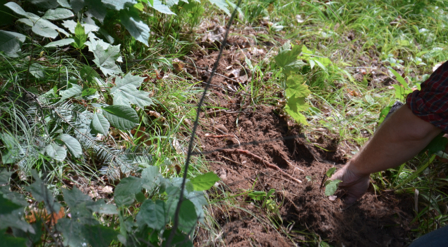
Wayne locates a suitable root at the foot of a tree (TD)
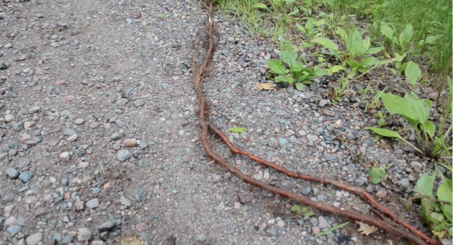
Spruce root after being removed from ground (TD)
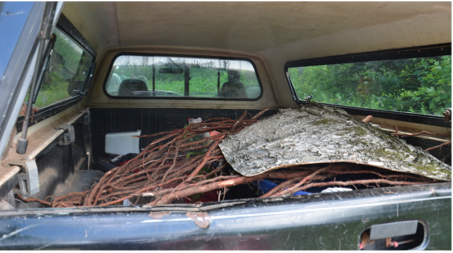
A supply of spruce roots and birch bark loaded onto the back of Wayne's truck to be taken home. Further preparation of the roots will take place at home (TD)
Watch Wayne Valliere show Tom Loeser how roots are split and skinned (TD)
Watch Tim Frandy explain to Tom Loeser how to split a spruce root into halves (TD)
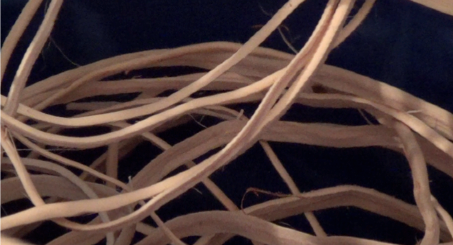
The prepared spruce root is narrow and flat so that it will join the separate pieces of birchbark securely (CC)
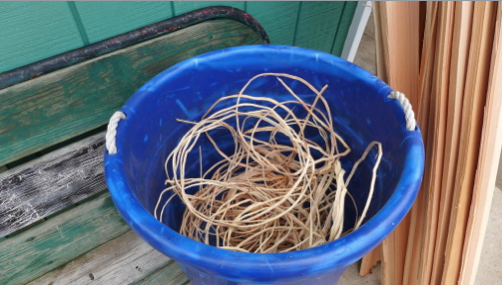
Prepared spruce root. The roots will be soaked in water to rehydrate them and make them pliable when it comes time to stitch the canoe (CC)
(back to top)
Red cedar
Wayne purchased four lengths of 16-foot clear red cedar from a lumber mill in the Pacific Northwest. These pieces were to be used for the gunwales and inwales of the canoe. Although such white cedar could be harvested locally, these pieces were purchased to save time and to use resources that are more abundant. The pieces were cut and then soaked in a lake near Wayne's home on the Lac du Flambeau reservation for one month. Then the pieces that were to become the inwales were removed from the water and gently bent to form the top outline of the canoe. The bent pieces were held in place with supports and string until they dried.
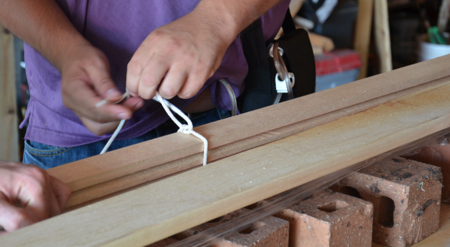
Cut pieces of red cedar are bundled together at Wayne's garage studio (TD)
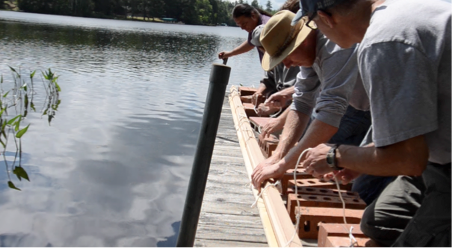
Wayne and his crew securely tie the cedar pieces to a set of bricks so that they can be submerged in a lake alongside a dock near Wayne's home (TD)
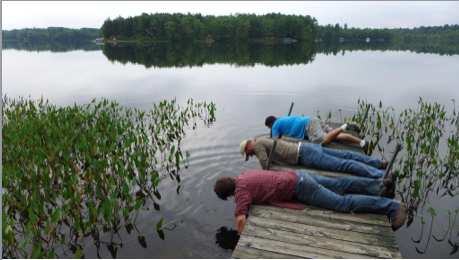
One month later, two of the pieces are retrieved from the lake to be formed into the gunwales(CC)
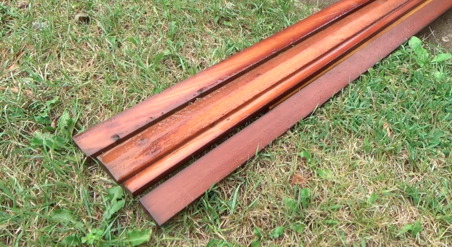
Through soaking, the pieces have taken on a rich red hue and are much more flexible than when dry (CC)
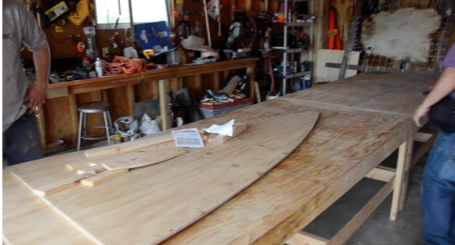
Although traditionally Anishinaable built their canoes on the ground on a surface of sand, Wayne prefers to use a work table and plywood form to give his canoes a greater degree of straightness and to reduce the amount of stooping required in the building process. An identical table was built at the UW-M wood shop for continuing the building in Madison (TD)
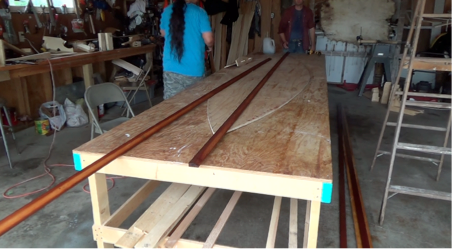
The soaked pieces placed on the work table (MC)
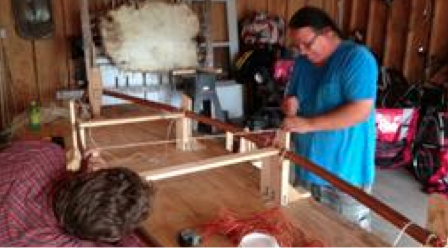
A series of height-blocks and temporary thwarts lets Wayne place the gunwale pieces in their proper place and bend them into shape. Lengths of string are used to tie the pieces in place as they dry (MC)

The gunwale pieces, already losing their hue as they start to dry, are fit into the prepared manboard and then lashed tightly in place using string (TD)
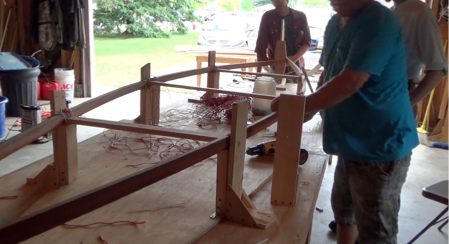
The pieces were now left to dry in place. Once the gunwale pieces dried, the pieces were disassembled, wrapped in bubble wrap, and prepared for transportation to Madison (MC)
(back to top)
Bigiwizigan: pine pitch
Though the harness stitch is highly effective at creating a good and watertight seam, the canoe is pitched with a glue made by mixing the pitch of pines (or spruces) with deer fat and wood ash. This glue seals stitches, holes, cracks, and cuts in the bark. Pitch can be harvested by using a hatchet to knock dried and hardened pitch off the outside of a scarred tree, or by harvesting fresh and sticky pitch off a cut. Pitch runs best during the heat of the summer.
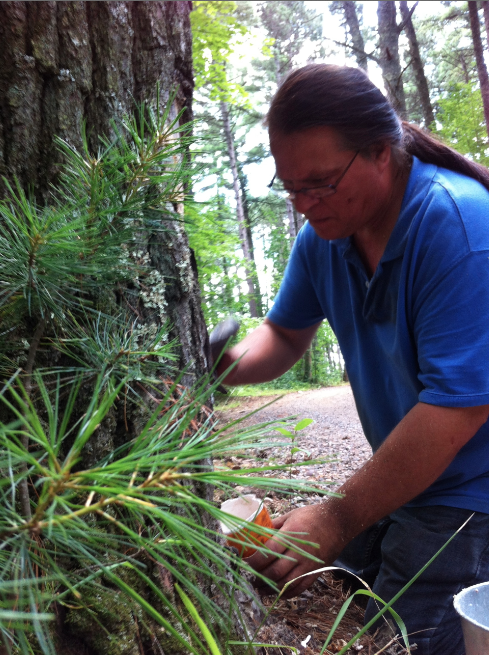
Wayne collecting pine pitch (TF)
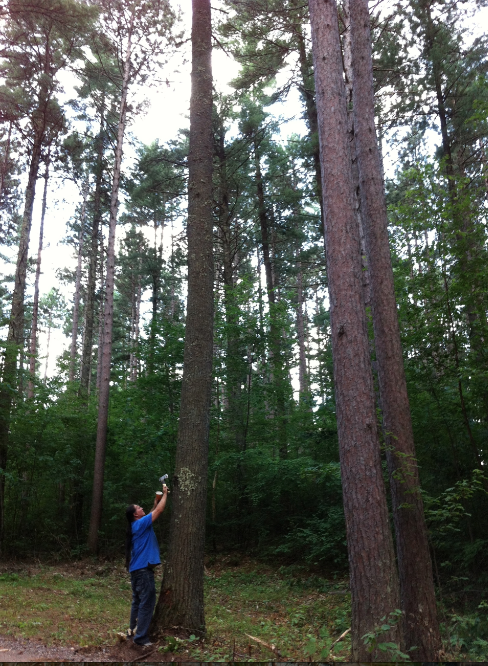
Wayne collecting pine pitch from tall tree (TF)
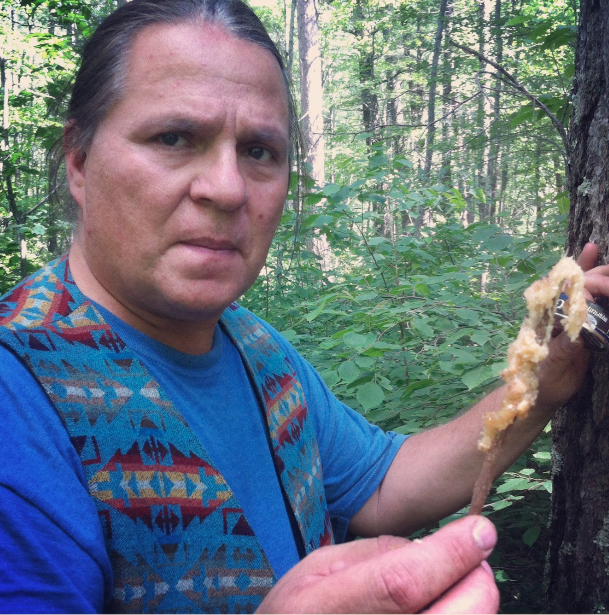
Here
(back to top)
Latest Work
Sponsors and Partners:
Windgate Charitable Foundation
University of Wisconsin-Madison Department of Art: http://art.wisc.edu/
Lac du Flambeau Tribe: http://www.ldftribe.com/
University of Wisconsin-Madison Department of Comparative Literature and Folklore Studies: http://folklore.wisc.edu/
University of Wisconsin-Madison Collaborative Center for Health Equity: https://ictr.wisc.edu/HealthEquityCenter
Center for the Study of Upper Midwest Cultures: http://csumc.wisc.edu/
University of Wisconsin-Madison Office of the Vice Provost and Chief Diversity Officer
Wisconsin Humanities Council: http://www.wisconsinhumanities.org/
The Brittingham Foundation
Goodman Community Center: http://www.goodmancenter.org/
Lac du Flambeau Tribe's ENVISION program
Links of interest:
A film of Cesar Newashish, a skilled Attikamek canoe builder: http://www.nfb.ca/film/cesars_bark_canoe/
A Youtube video on Wayne Valliere's construction of a birchbark canoe, summer 2012: http://www.youtube.com/watch?v=7hrFbYT4L6U
A Powerpoint presentation of birchbark canoe projects created by the Fond du Lac Band of Lake Superior Chippewa:
http://www.fdlrez.com/museum/Wiigwaasi%20Jiimaan%202010.pdf
Woodland Indian Art Center, Lac du Flambeau reservation:
http://www.woodlandindianartcenter.org/
Photo credits:
CC Colin Connors
MC Marcus Cederström
TD Tom DuBois
TF Tim Frandy
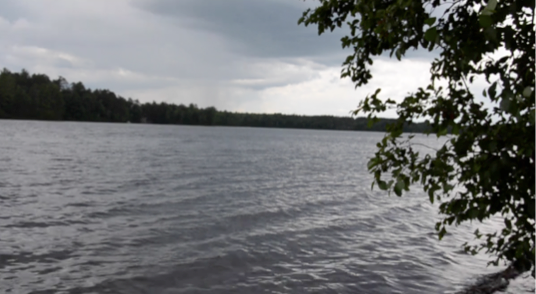
View of one of the many lakes on the Lac du Flambeau reservation, July 2013 (TD)